The topic of whether you should create a landing page or a blog post to go after SEO keywords has come up a lot over the last 4 years of running our agency.
Typically, it comes up when we’re discussing going after a bottom-of-funnel SEO keyword with a blog post. For example, a software category keyword like “proposal creation software.”
In this scenario, the client will often ask us, “shouldn’t we create a landing page instead of a blog post for that?” And in many cases, when we look at what’s already ranking for a keyword like that, product landing pages are one of the primary page types in the SERPs (alongside home pages and list-style blog posts).
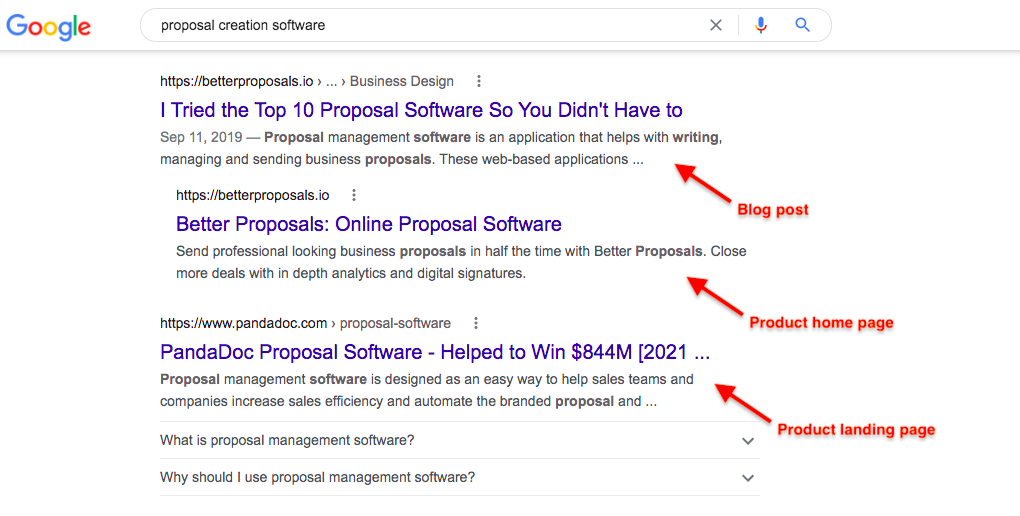
Whether to target a keyword with a landing page or a blog post is a legitimate question.
The main argument for going after a keyword with a landing page (instead of a blog post) is that landing pages convert better. So they think you should use landing pages for bottom-of-funnel, product based keywords, which have high product conversion intent, and save blog posts for mid and top funnel keywords that are more informational.
On the surface, this sounds logical.
But, in our experience, when you get into the fine details, you realize this simple argument may not be true. In fact, we almost always target bottom-of-funnel keywords with blog posts, not landing pages, and have seen a lot of success doing so.
There are a number of reasons why:
- Conversions: Conversion rates of product landing pages are not always higher than conversion rates of blog posts (even for equivalent types of BOF keywords). We think this misconception comes from thinking about landing pages in the context of paid ads (search and social), where conversion rates can sometimes be as high as 10% – 20%. But from what we’ve seen, in the context of ranking product landing pages for organic positions (what we’re referring to as a “product landing page”), it’s not automatic that they have a higher conversion rate than blog posts. We have anecdotal evidence to support this, which we’ll discuss below.
- Ranking: It’s often much more difficult to get a landing page to rank highly in organic search. A blog post format gives you more room to include relevant SEO keywords and answer the intent of the searcher, so blog posts are often easier to get ranking highly. And ranking needs to take priority first, since if your page doesn’t rank, it won’t matter how high your conversion rate is.
- Intent: Often the intent of a BOF product category keyword is to view options, in which case a blog list post will often rank more highly than product landing pages (like in the screenshot above) because they’re better at satisfying search intent.
In this post, we’re going to share data and examples backing up these claims. Specifically:
- Anecdotal data that indicates product landing pages don’t always convert better than blog posts, and in some cases, convert at a significantly lower rate.
- The framework we use to decide when to use one or the other.
- Examples of blog posts we’ve created for clients where they’re outranking product landing pages for BOF keywords.
- A hybrid strategy of combining landing pages and blog posts.
The Idea That Product Landing Pages Convert Better than Blog Posts Isn’t Always True
In 2020, we were working with a SaaS client and one of their team members stood firmly on the side of creating product landing pages for BOF software category keywords. It started our own internal debate around this topic of landing page versus blog post conversion rates.
Devesh, who has run a conversion rate optimization (CRO) agency for years, was initially sympathetic to the client’s perspective—he felt that in his experience, a landing page structure does generally convert at a higher rate than most blog posts. But we decided to look into the data (examples below) and found what was, at first, a surprising conclusion.
The Notion of “High Converting Landing Pages” Tends to Come from Paid Search, Not Organic
Devesh was thinking of PPC landing pages that are highly optimized for conversion (excluding the main site navigation, reducing the number of options users can click on the page, etc.) and for which people are often self-qualifying when they click on an ad (most commonly a Google search ad).
For example, if you Google “data analytics software” (the kind of B2B SaaS term where PPC landing pages abound), you’re met with not one, not two, but four ad spots, all of which go to dedicated landing pages for each product (yes, we clicked on all four, sorry to these brands and their PPC agencies):
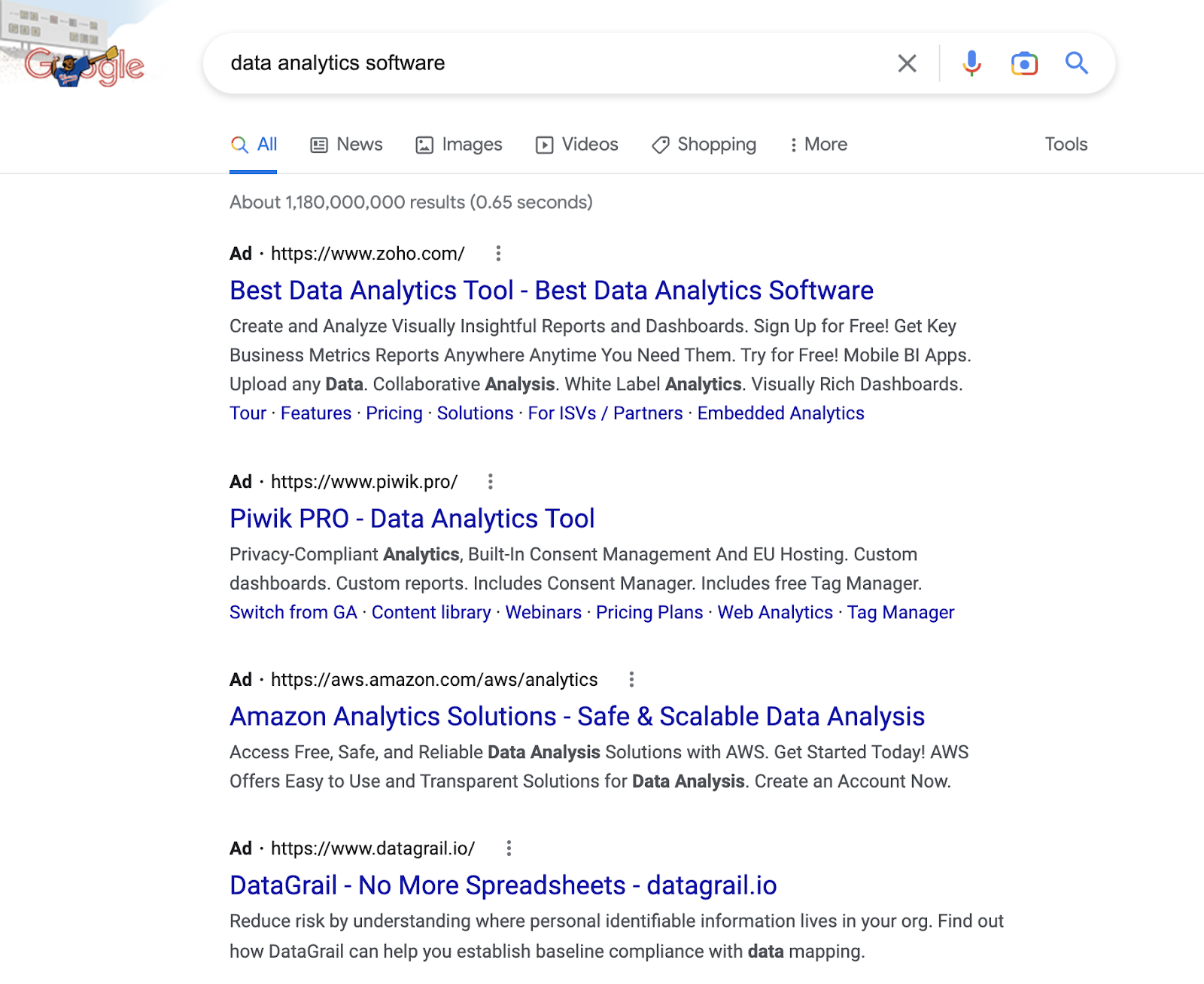
All of them have the same structure—a very common and well tested structure—of information on the left and a demo request or trial start form on the right, all above the fold:
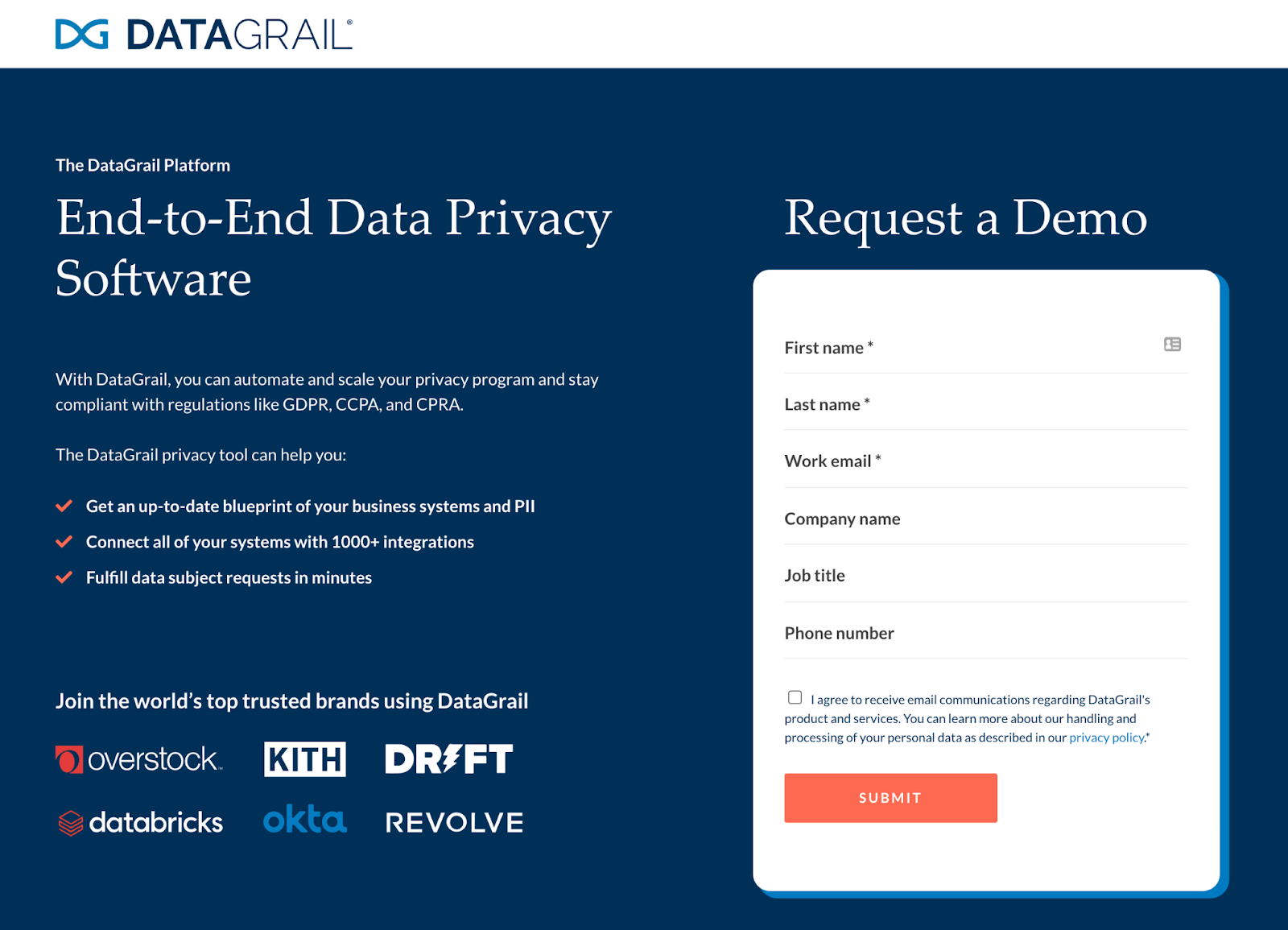
It’s a very aggressive, conversion-focused experience. And these landing pages can convert as high as double digits (10%+).
But think about the psychology of someone who clicks on that ad. They Googled a software related term and willingly clicked on one of the ads. They know what they are getting into.
Our hypothesis is that a larger fraction of these ad-clicking users are not in research mode but are ready to request demos or start trials—as evidenced by them willingly clicking those ads. In other words, if you click an ad, you are self-selecting as someone who is ready to be sold. As a result, conversion rates can be very high for these landing pages.
Organic Results Are Different: Blog Posts Can (And Have) Converted Better Than Product Landing Pages
But the organic listing spots can be a lot different. In the organic spots, as per data we’ll show below, we haven’t seen product landing pages convert much higher than blog posts.
There are a few reasons for why we think this is:
- Way more people click on organic listings than ads (e.g. tens of thousands of visitors in the example we share below). Pages getting that kind of traffic aren’t going to convert at 10%+.
- Someone scrolling down the SERP and clicking on an organic listing is slightly higher in the funnel and has less immediate purchase intent (i.e. they’re more in research mode) than someone who clicks on an ad.
- Compared to a blog post, a product landing page format is typically thin on content, providing less room to discuss a product’s positioning at length, educate visitors on how it’s different and better than competitors, etc.
So, to show some anecdotal data that supports this, here’s what we found when we compared conversion rates of blog posts versus landing pages for the client we mentioned above:
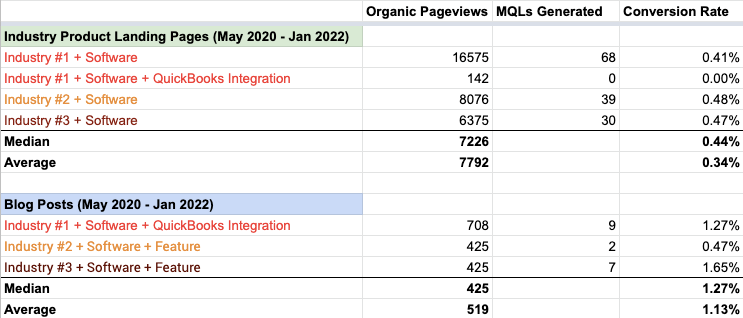
We calculated the conversion rates from organic traffic for three product landing pages and blog posts targeting closely comparable BOF keywords.
The data set on top looks at conversion rates for their industry product landing pages, and the data set on bottom looks at our blog posts for three of those same industries—the only difference being that for industries #2 and #3, we were targeting keywords that included industry + software + a specific feature.
For industry #1, we were essentially targeting the exact same keyword as the “QuickBooks Integration” version of the landing page. That post outranks the equivalent product landing page shown above (Industry #1 + Software + QuickBooks Integration), drives more organic traffic, and also has converted at 1.27% on average since it’s been published.
On average, you can see their conversion rate hovers in the 0.4% range for the product landing pages we looked at, whereas our blog posts convert at 1.13%.
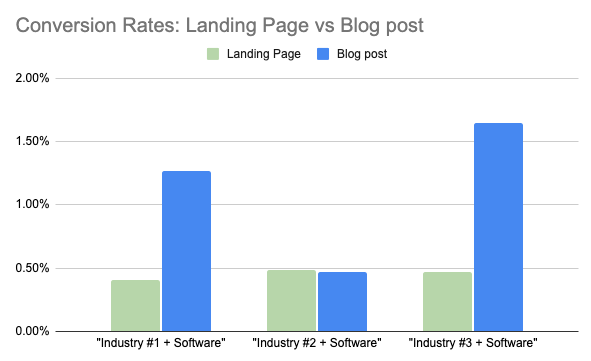
Yes, the traffic and conversion volume for the product landing pages is much higher overall. In part that’s a function of those pages having been published for a longer time period, and in part it’s due to those head target keywords (“industry + software” vs. “industry + software + feature”) having higher search volume. However, the purpose of gathering this data was to look specifically at conversion rates, because that’s the most common reasoning behind using landing pages over blog posts for BOF terms.
This is obviously a small data set and not a perfect comparison, but it’s illustrative of the fact that product landing pages do not always convert at a higher rate than blog posts. They usually do because most companies don’t write BOF blog posts that sell their product in a compelling way. But blog content that does this can convert just as high or higher than product landing pages.
And, blog posts are typically easier to get ranking highly in the SERPs, which we’ll discuss more in the next section.
Note: If you’d like to learn our content strategy and apply it to your business, we teach everything we do and give personalized feedback in our content marketing course and community.
Our Framework for Deciding When to Go After a Keyword with a Blog Post vs. a Landing Page
Now, just because we’ve dismissed the idea that landing pages generally convert better than blog posts doesn’t mean there is no decision to be made. It still may be the case that for a given keyword a landing page (or just a more product-focused page) is better than a blog post.
To help make that decision, we look to SERP analysis, which (among other steps) involves reviewing the titles, page types, and sources of existing page one results.
When we’re looking at search results for a BOF keyword, like a software category keyword, we’re first looking to understand:
- Which page types are showing up? (e.g. Software review lists? Competitor product home pages? Competitor product landing pages? Blog posts?)
- Would a blog post be an appropriate fit for satisfying search intent?
- Would a blog post have a good chance of ranking in the top 3 positions?
- What type of blog post would most closely satisfy search intent?
If all or a majority of the results are blog posts, the decision is easy. A blog post can rank highly and satisfy search intent.
However, often there’s a mix of product landing pages and product home pages with just a few blog posts (or sometimes none at all). This is when we need to figure out whether a) it’s still worth creating a blog post or b) our client would be better off going after that keyword with a product landing page.
Here’s how we think about this:
First, we take into consideration our client’s authority in their space. Are they a super well known brand that generally has an easy time getting product pages to rank for competitive BOF keywords?
If that’s the case, it may well make sense for them to create a product landing page due to the majority of the SERP being landing or product pages suggesting that perhaps that’s what the user is looking for—not a wordy blog post.
However, if they aren’t a super well known brand in the space that search engines recognize as an authority, it’s likely that client may have low chances of ranking a product page—which has less space for including relevant keywords, increasing time spent on site, and improving other ranking factors which Google takes into account when ranking web pages.
In this case, we’ll often choose to go ahead with a blog post because it gives our client a more realistic chance of ranking. (Which, again, has to take first priority because if a page doesn’t rank, the format of the page won’t make a difference.)
Then it becomes a question of which type of post we’ll write. We’ll often do a list post because as we mentioned above, these types of posts often rank highly for BOF product and service keywords where search intent is to view and weigh options against each other.
Note: A lot of companies feel hesitant or unwilling to write list-style posts because they don’t want to draw attention to their competitors. However, we’ve found that the advantages of leveraging that format—which in many cases increases the chances of ranking in a top spot—outweighs the disadvantages of mentioning their competitors. We’ve found that when list posts are done well, they’re very effective for ranking and producing conversions. And they can also aid your sales process by talking up your key value props relative to competitors upfront. Ultimately, if people are Googling a product related keyword and seeing lists of products and you’re not controlling that conversation, you’re just leaving those conversions and customers on the table. If what it takes to rank highly for one of these high-converting keywords (and capture the customers searching for it as a result) is listing products beyond just yours, we think it’s more than worth it.
Next, we’ll share examples where we’ve earned top positions in the SERPs for BOF keywords, where many of the search results are product landing pages.
Client Examples of Blog Posts Outranking Product Landing Pages for BOF Keywords
We rank #1 with a blog post—in a SERP of mostly product landing pages—for the keyword “clock in clock out app” for our client Buddy Punch, an employee time clock software and app:
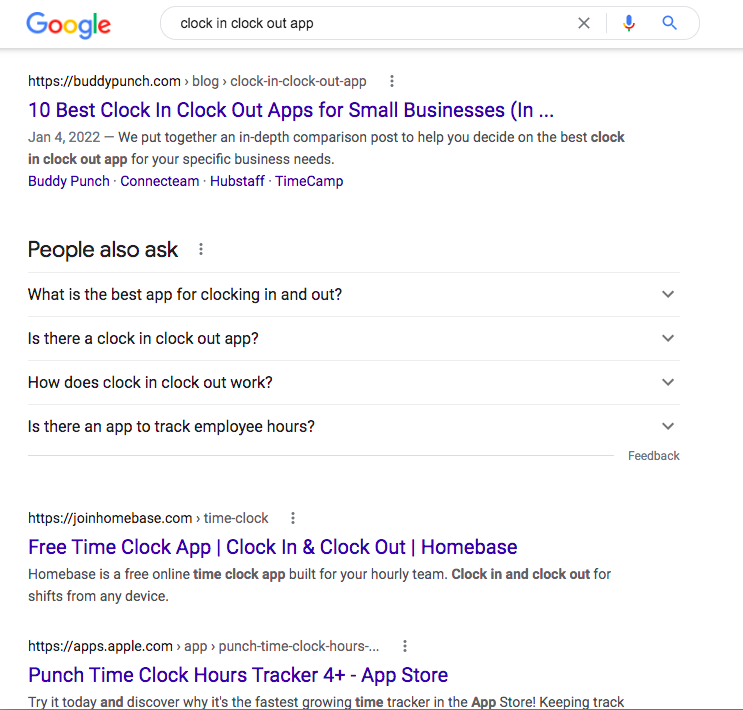
We also rank #1 for Buddy Punch for “mobile time clock app” with a blog post where 7 of the results ranking below us are product landing pages and home pages:
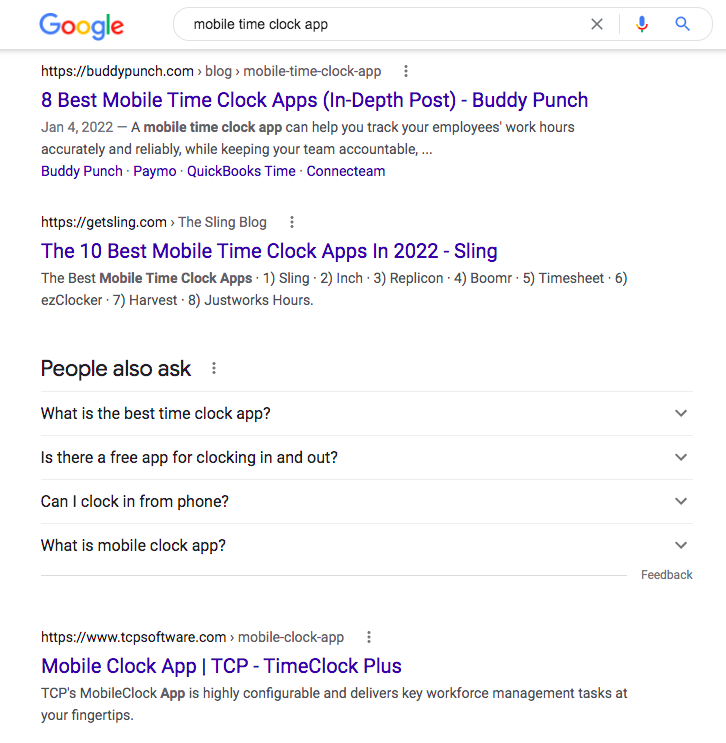
We’re ranking #2 underneath G2 for the keyword “sales onboarding software” with this list post for our client Bigtincan:
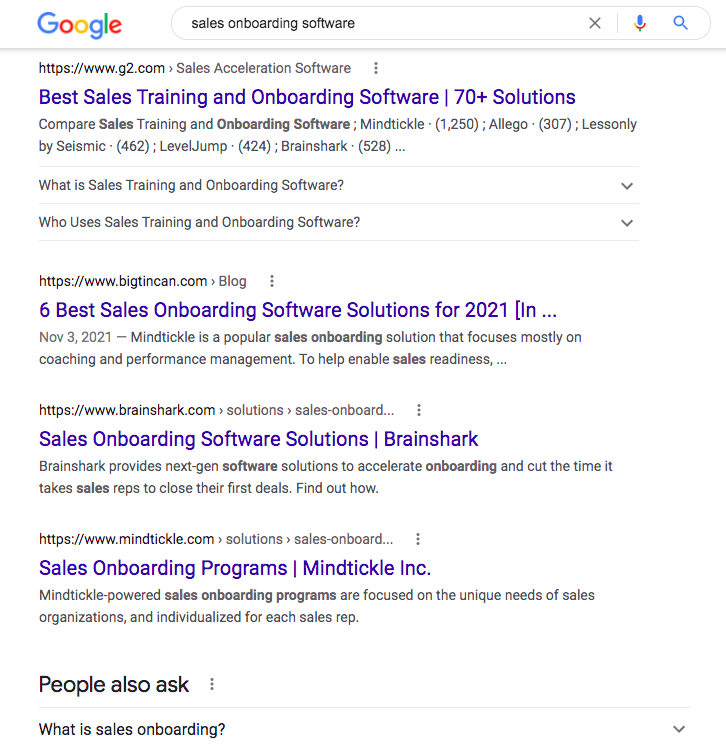
Notice how results in positions #3 and #4 are product landing pages (there are also several others below).
We’re ranking #1 for the keyword “delivery mapping software” for our client Circuit, with two product home pages ranking below:
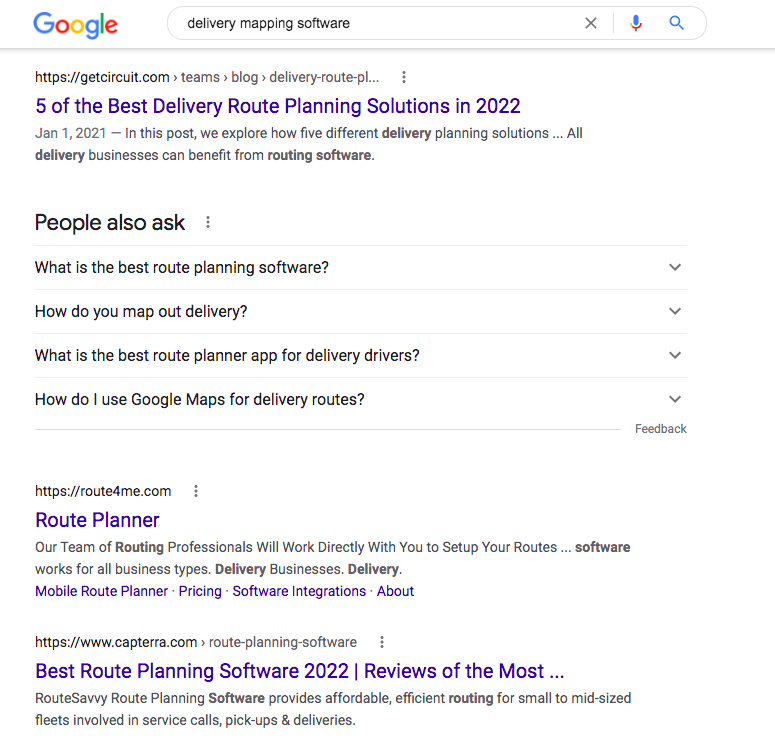
We’re ranking #1 for the keyword “video to text transcription software” for our client Reduct:
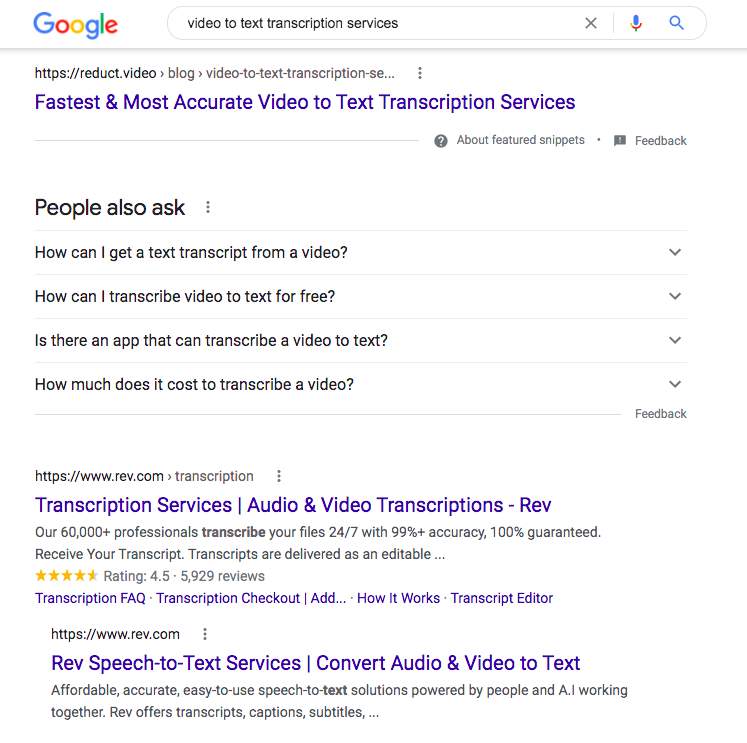
Notice the two results below—a product landing page and a home page. There are several other home pages lower on the page as well.
The above examples are just a sample, there are many more like this across dozens of clients.
We can see that there are many cases in which a list-style blog post can better satisfy search intent for BOF products or service keywords, and therefore outrank competitors’ product landing pages.
When you take into account that, on average, search results in position 1-3 receive ~60% of organic traffic, even if the list post does have a lower conversion rate—which as we showed above isn’t always true—the increased organic traffic can easily still produce a higher volume of conversions.
So, when you’re choosing whether to create a landing page or blog post for any given BOF keyword, it’s worth considering this in your decision making process.
Note: Interested in whether we can drive these types of results for your business? Learn more about our content marketing service here.
The Hybrid Strategy: Combining Landing Pages and Blog Posts
Some companies and marketers are beginning to use a hybrid strategy where they create a template that folds blog content into a traditional product landing page structure.
The thinking is that the editorial content from the blog post can help the page rank higher, while the landing page structure can increase conversion rates.
Our client ServiceTitan has been experimenting with this on their competitor comparison pages. We write comparison blog posts optimized for “[Competitor] vs. ServiceTitan”—and they place that editorial content within a landing page template.
The top of the page uses a common landing page format:
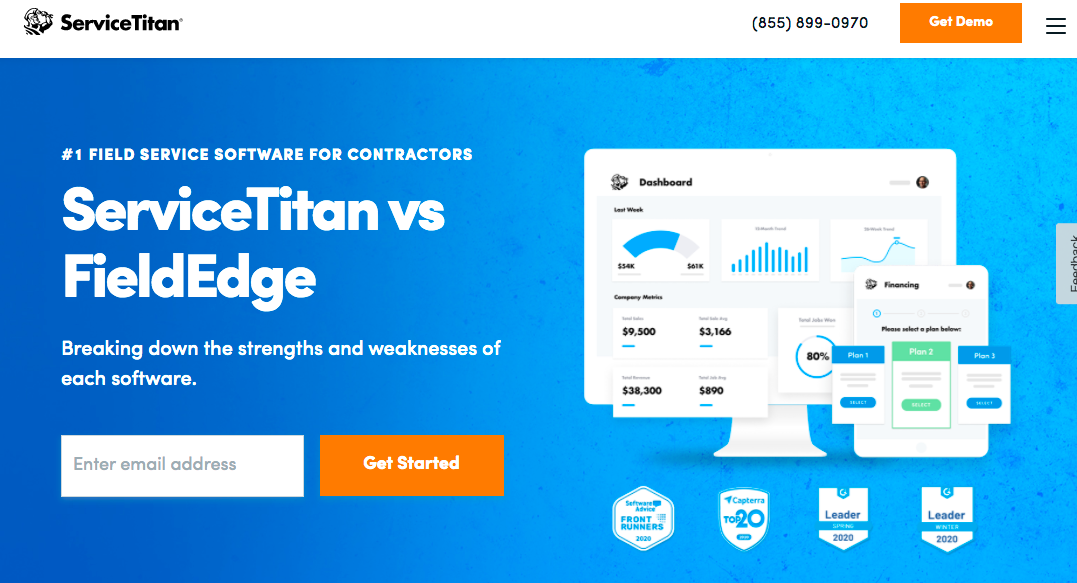
Beneath that, they use a comparison table, which is another common element of a product comparison landing page:
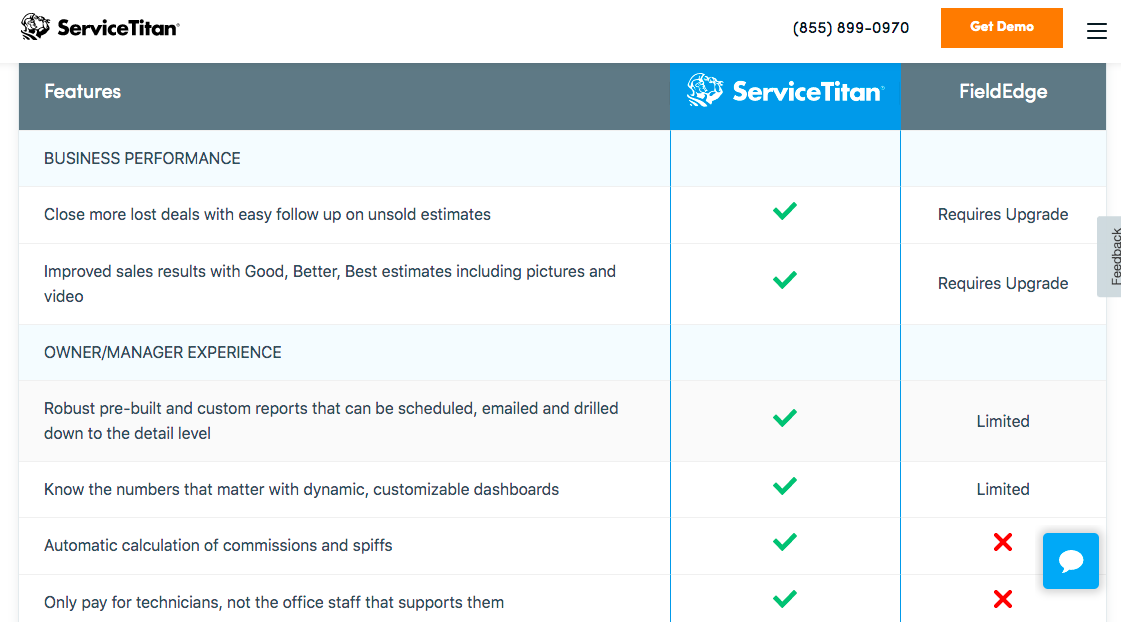
And beneath that, they place our blog post with a Table of Contents for easy navigation:
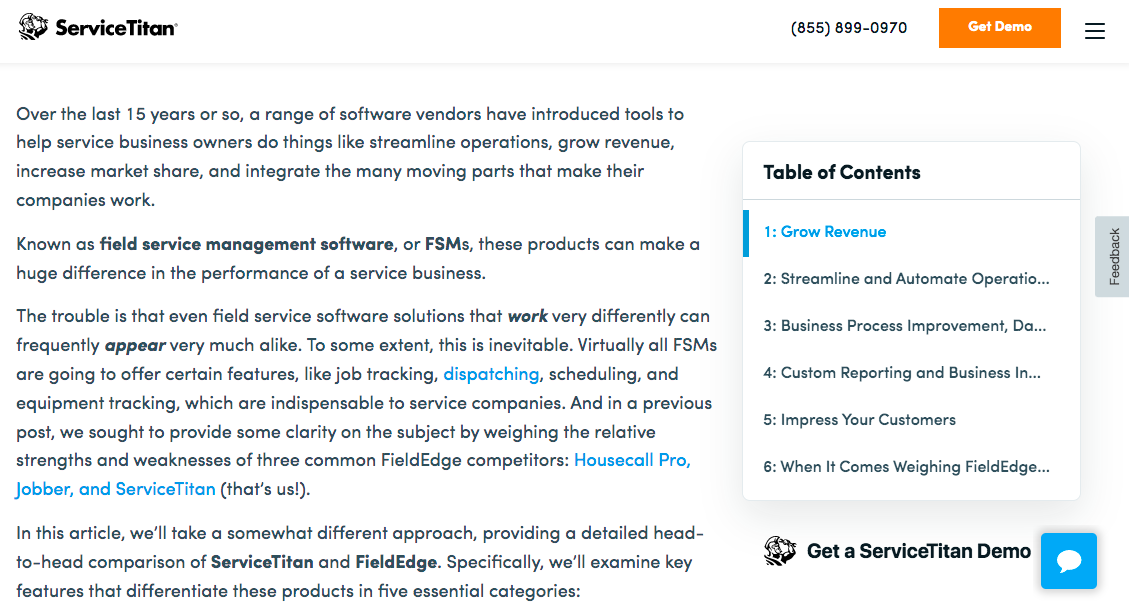
Below, you can see them ranking in position #1—above Software Advice, G2, and one of their top competitors, Housecall Pro:
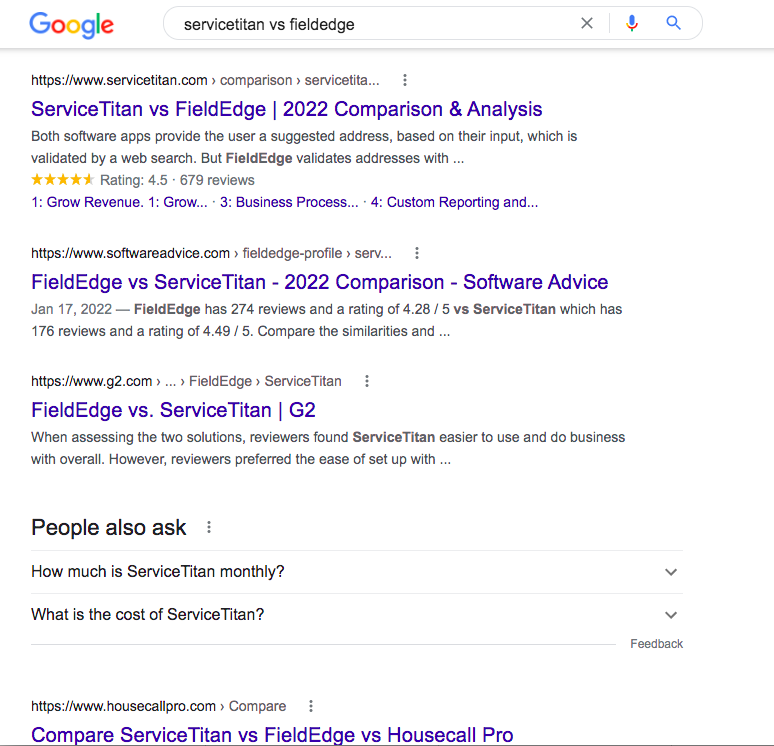
Whereas, Ahrefs shows them ranking in position #3 (below Software Advice and Capterra) back in December 2020 prior to publishing the blog content on that page:
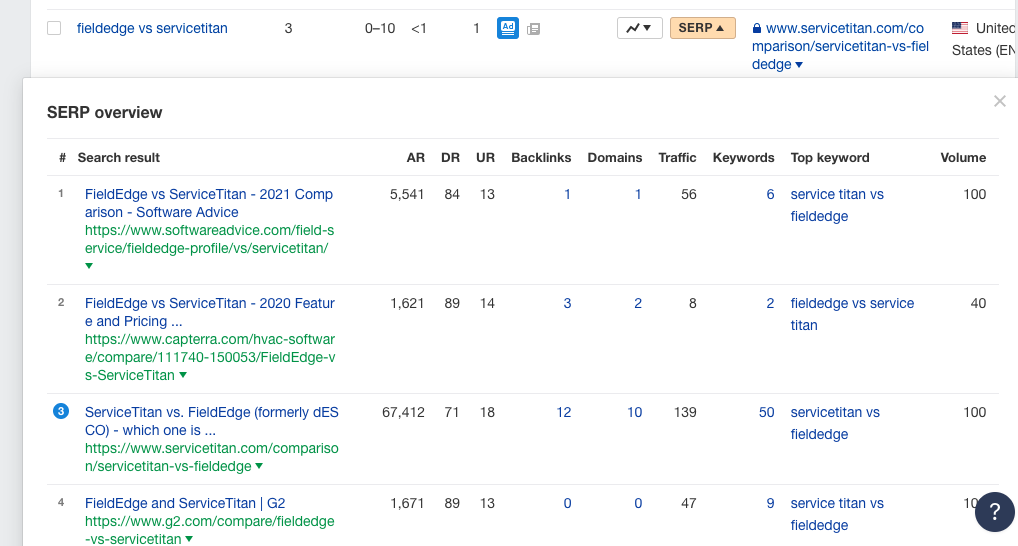
In ServiceTitan’s case, they had pre-existing (and already ranking) comparison landing pages that they added the blog content to which boosted the rankings even higher.
However, there are other ways you can consider approaching this. For example, you could create the blog post first to have the highest likelihood of ranking. And then once you’ve achieved that ranking, build a landing page-style template around it later to optimize the page for conversions.
Or, you could create a hybrid page from the get-go. Either way, based on what we’re seeing, it’s absolutely worth testing a hybrid strategy.
Get Help on Your SaaS Content Marketing
- Questions/Comments? If you have any questions or comments about what we’ve discussed in this post, please let us know in the comments section below.
- Our Agency: You can learn more about working with us here.
- Our Content Marketing Course: Individuals looking to learn our agency’s content strategy and become better marketers, consultants, or business owners can join our private course, taught via case studies. We include several details and examples not found on this blog. Our course is also built into a community, so people ask questions, start discussions, and share their work in the lesson pages themselves, and we, along with other members, give feedback. Learn more here or see this video walkthrough:








